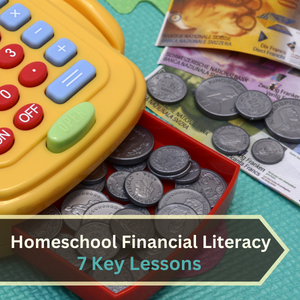Greetings, homeschooling families! Today, we’re embarking on a financial literacy journey tailored to our younger learners. In a world where financial knowledge is as crucial as academic skills, introducing finance and economics to elementary-aged kids sets the foundation for wise resource management, credit understanding, and money tracking later in life. By incorporating simple, engaging lessons on money into your homeschool curriculum, you’re not just teaching your children about currency but preparing them for a future of financial confidence and competence.
The Importance of Teaching Homeschool Financial Literacy
Instilling financial literacy from a young age equips children with the knowledge and skills to make informed financial decisions throughout their lives. It lays the groundwork for financial responsibility, smart money management, and future financial independence. By incorporating these lessons into your homeschooling routine, you’re not just teaching academic skills but preparing your children for real-world success.
Through these lessons and activities, children learn the value of money, the importance of saving, the basics of budgeting, and the concept of interest. Each lesson builds upon the last, creating a comprehensive curriculum that will serve your homeschooler for years to come. Start these important conversations today, and watch as your young learners grow into financially savvy individuals.
Creating a Kid-Friendly Financial Literacy Curriculum
Building a financial literacy curriculum for young homeschoolers means turning complex concepts into fun, accessible lessons. Here’s how to lay the groundwork for a lifelong healthy relationship with money through activities that cover earning, saving, spending, and sharing.
Lesson 1: Earning and Saving Money
Objective: Understand Credit: Introduce the concept of earning money and the importance of saving.
Materials Needed:
- Play Money, an Investment Guide:
- Piggy bank or clear jar
- Printable job chart with simple tasks
Steps:
- Introduction to Earning: Start with a story or discussion about how people earn money by working different jobs. Highlight the idea that money is earned, not just given.
- Track Earnings and Save Activity: Create a job chart with simple tasks (e.g., tidying up toys and helping with dishes). Assign a small amount of play money for each task completed.
- Saving with a Purpose: Have each child choose a savings goal, like a new toy or book. Discuss how saving money from their ‘jobs’ can help them reach that goal.
- Reflection: Discuss the experience of earning, saving, and tracking resources. Ask children how it feels to see their savings grow and what they look forward to buying with their money.
Lesson 2: Smart Spending
Objective: Teach the value of money and making smart spending decisions.
Materials Needed:
- Play money
- Price tags (create your own for various household items or toys)
- Shopping list template
Steps:
- Understanding Value: Explain that items cost money and prices vary. Use price tags on household items to show how much things might cost.
- Shopping List Activity: Give each child a set amount of play money and a shopping list template. Let them choose items they’d ‘buy’ from around the house, sticking to their budget.
- Making Choices in Personal Finance: Discuss the importance of making choices when shopping, such as deciding between two items or choosing not to spend at all.
- Discussion: Reflect on the shopping activity. Talk about why it’s important to think carefully before spending money and how it feels to make smart spending decisions.
Lesson 3: Sharing and Giving
Objective: Highlight the importance of sharing and giving part of our money to help others.
Materials Needed:
- Play money
- “Donation box” (any container will do)
- Pictures or stories of charities or causes suitable for children
Steps:
- Introduction to Giving: Share stories or pictures of different charities and causes, explaining how donations help others.
- Earn, Save, Give Activity: From the earnings in Lesson 1, encourage children to set aside a portion to ‘donate’ to a cause they care about. Place their donations in the donation box.
- The Joy of Sharing: Discuss how giving can make a difference and the positive feelings of helping others.
- Lesson 4: Budgeting BasicsObjective: Introduce the concept of budgeting as a way to plan spending, saving, and giving.Materials Needed:
- Printable simple budget template for kids
- Play money
- Magazines or printed pictures of items (toys, food, clothes)
- Understanding a Budget: Explain a budget and why it’s essential. Use a simple budget template to show how money can be divided into categories like ‘Needs,’ ‘Wants,’ and ‘Savings.’
- Budgeting Activity: Give each child a set amount of play money. Let them browse through magazines or pictures to choose items they would allocate their budget to, including savings and donations.
- Making Decisions: Highlight the importance of making choices within a budget. Discuss the difference between needs and wants.
- Reflection: Talk about the experience of creating a budget. Ask what was easy or hard about deciding how to spend their money.
- Simple interest calculator (or a chart showing how interest works)
- Play money
- “Bank” and “Loan” signs
- Introducing Interest: Explain interest as money earned from savings or paid when borrowing. Use simple examples or a chart to illustrate.
- Banking Activity: Set up a ‘bank’ where children can ‘deposit’ play money to earn interest. Show how their money can grow over time with interest.
- Understanding Loans: Discuss borrowing money and how interest means paying back more than borrowed. Use a ‘loan’ scenario for illustration.
- Discussion: Reflect on what they learned about interest and its impact on saving and borrowing.
- A variety of coins and bills (real or play money)
- Items with price tags for a mock store
- Money Identification: Identify different coins and bills and discuss their value.
- Spending Wisely in Personal Finance: Set up a mock store with items priced with tags. Give children a budget, and let them choose how to spend their money.
- Earning Money: Explain that money is earned by working. Discuss simple jobs they could do to earn money.
- Reflection: Discuss the importance of personal finance, working for money, and making wise economic choices on spending and investing it.
- Goal-setting worksheet
- Vision board materials (magazines, scissors, glue, poster board)
- Play money
- Goal Setting: Help children identify and write down long-term goals (e.g., buying a bicycle, going to college).
- Vision Boards: Create vision boards that represent their goals. Discuss how saving money can help achieve these dreams.
- Saving Activity: Introduce the concept of setting aside money regularly for future goals. Use play money to simulate saving towards their goals.
- Reflection: Talk about the importance of planning for the future and how saving is a key part of achieving their dreams.
- Integrate with Math: Use lessons on budgeting, spending, and saving as practical applications of math skills.
- Reading Time: Select books and stories that include financial concepts, personal finance or characters making financial decisions.
- Art Projects: Use activities like creating vision boards to integrate financial literacy with art.
- Weekly or Monthly Themes: Dedicate a week or month to a specific financial literacy topic, allowing for deep dives into subjects like saving, budgeting, or the value of money.
- Real-Life Practice: To reinforce lessons learned, involve children in real-life financial decisions, such as grocery shopping on a budget or planning family outings.Reflection: Talk about the experience of sharing with others. Ask children how they decided which cause to support and what they learned from the activity.




